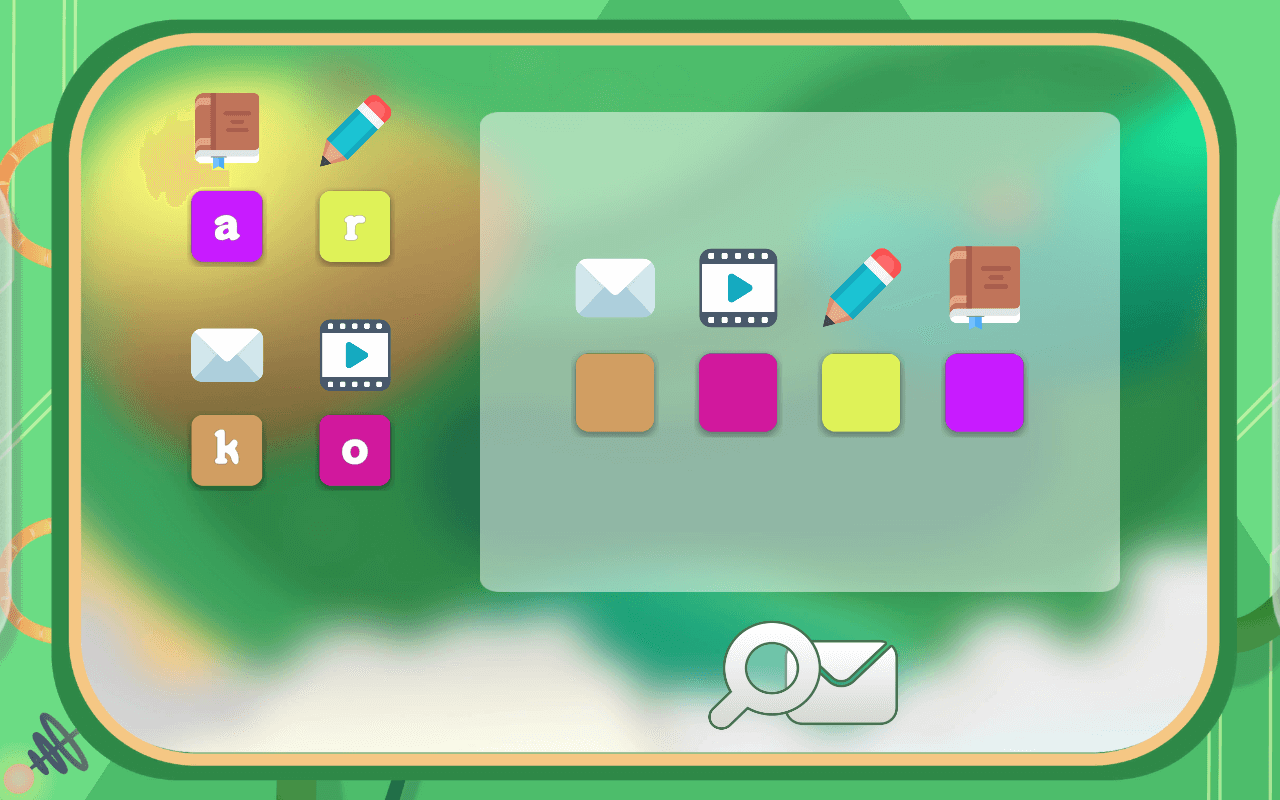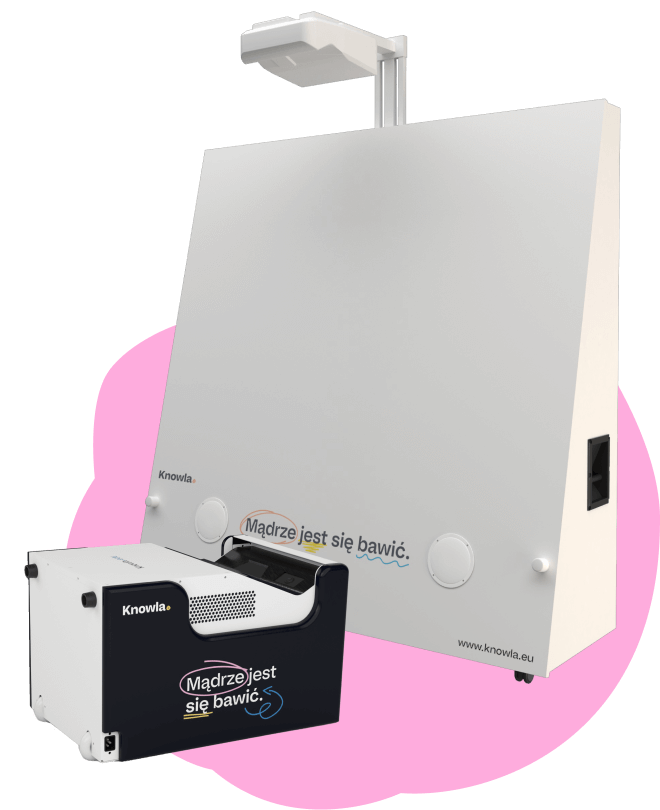Klasy: wczesnoszkolne 1-3
Temat: Szyfrujemy wiadomości.
Cel ogólny:
Powtórzenie alfabetu oraz zapisu wyrazów.
Zapoznanie uczniów z szyfrowaniem.
Wprowadzenie do algorytmiki i programowania.
Cele operacyjne:
Uczeń przypomina sobie alfabet oraz zapis wyrazów.
Uczeń wie, jakie cechy powinien posiadać dobry szyfr.
Punkty podstawy programowej:
Uczeń poznaje różne sposoby kodowania i dekodowania wiadomości.
Cele kształcenia – wymagania ogólne: IV.1,6
Treści nauczania – wymagania szczegółowe: I.4.4,2. I.5.6. I.6. VII.1.3.
Czas pracy: 2 godziny lekcyjne
Metody i formy pracy: dyskusja, własna prezentacja uczniów, zabawa, praca własna, praca w grupie
Edukacyjny Wszechświat Knowla:
- Poszukaj literek – Planeta M
- Rysuj litery po śladzie – Planeta M
- Koloruj według liter – Planeta DŻ
- Złam szyfr – Planeta DŻ
- Twórz muzykę – Planeta Smart
Przebieg zajęć:
- Przypominamy sobie alfabet
- Przypominamy uczniom cały alfabet, który będzie później przydatny do kodowania wiadomości w większości szyfrów. Możemy zrobić to za pomocą np.:
- Poszukaj literek – Planeta M
- Rysuj litery po śladzie – Planeta M
- Koloruj według liter – Planeta DŻ
- Przypominamy uczniom cały alfabet, który będzie później przydatny do kodowania wiadomości w większości szyfrów. Możemy zrobić to za pomocą np.:
- Dyskusja
- Pytania (mogą być do wyboru wedle preferencji):
- Czym jest szyfr?
Innym sposobem na zapisanie informacji niż alfabet, który znamy. - Co jest ważne?
Sposób kodowania i dekodowania wiadomości, który obie strony muszą znać. - Kto może znać sposób na kodowanie i dekodowanie wiadomości?
Tylko osoby, które potrafią zakodować i odkodować wiadomość. - Jaki może być sposób kodowania wiadomości?
Dowolny: obrazkowy, dźwiękowy, znakowy, sygnalizacyjny, ruchowy, flagowy, graficzny, sensoryczny… - Czy zapisanie słowa za pomocą kolorów samogłosek i spółgłosek jest szyfrem? Czy jest dobrym szyfrem, czy złym?
Złym, bo np. dwa słowa będą miały taki sam zapis: miło-było - Kolorowy szyfr: Koloruj według liter (Planeta DŻ)
- Prosimy uczniów o pokolorowanie określonych liter.
- Pytanie: Czy to może być szyfr i dlaczego?
- Czy Kolorowanie po cyferkach – Planeta Pi może być szyfrem?
- Jakie cechy musi zawierać dobry sposób szyfrowania?
- sposób na kodowanie i dekodowanie, który nie będzie łatwy do odgadnięcia przez innych
- po zakodowaniu i zdekodowaniu według klucza wiadomość powinna brzmieć tak samo
- szyfr powinien być trudny do złamania
- zakodowana wiadomość nie powinna być możliwa do odczytania, to znaczy, że nie powinno się dać z niej odczytać prawdziwej wiadomości
- elitarność grona, które zna klucz do odczytu wiadomości
- Co jest potrzebne do zaszyfrowania wiadomości?
- wiadomość
- klucz, którym można kodować i dekodować wiadomość
- odpowiednia forma do przekazania wiadomości, np.: papier, ruchy ciała, zapisana melodia
- wiadomość, zakodowana wiadomość i klucz nie powinny być blisko siebie
- Jaka nauka zajmuje się szyframi?
Kryptologia - Czym była Enigma i komu udało się ją załamać?
- Przenośna elektromechaniczna maszyna szyfrująca, oparta na mechanizmie obracających się wirników. Maszyna ta po ustawieniu początkowych wskaźników zamieniała litery według swojego algorytmu. Działa na zasadzie kilkukrotnego szyfru przestawiennego (każdą literę zamieniamy na inną według klucza). Do rozszyfrowania wiadomości niezbędna była znajomość kolejnych kluczy szyfru przestawiennego, które zmieniały się po jakimkolwiek przestawieniu ustawień początkowych. Enigma wykorzystywana była do przekazywania między sobą wiadomości przez stronę niemiecką w czasie II wojny światowej.
- Szyfr enigmy został złamany przez polskich matematyków (Marian Rejewski, Jerzy Różycki, Henryk Zygalski) za pomocą równań matematycznych. Ich praca przysłużyła się do odczytania ok. 75% wiadomości niemieckich transmisji do 1938. Ich praca kryptograficzna została wykorzystana również przez Alana Turinga (Anglia) przy budowie maszyny dekodującej wiadomości (przedstawione m.in. w filmie Gra Tajemnic).
- Więcej informacji, np.: https://eduinf.waw.pl/inf/hist/006_col/0005.php
- Czym jest szyfr?
- Pytania (mogą być do wyboru wedle preferencji):
- Planeta DŻ złam szyfr
- Włączamy aktywność, dostosowując poziom do poziomu uczniów. Dostępne są 3 poziomy, poziom 1 dedykowany jest dla dzieci najmłodszych – 3-6-letnich, poziom 2 – 6-7-letnich, poziom 3 – 8-9-letnich.
- Na początek zasłaniamy klucz, znajdujący się po lewej stronie i pytamy, czy są w stanie odgadnąć, jakie słowo zostało zakodowane.
- Prezentujemy klucz szyfru i pytamy, jak sądzą, w jaki sposób działa.
Każdy obrazek i kolor odpowiada jednej z liter alfabetu. - Wspólnie dekodujemy pierwszy wyraz, a uczniowie zapisują go w zeszycie.
- Następnie organizujemy wyścigi. Zadaniem uczniów jest odszyfrowanie kolejnych wyrazów oraz zapisanie ich w zeszycie. Jak to zrobią, podnoszą rękę do góry. Kiedy wszyscy skończą, ujawniamy wspólnie hasło oraz sprawdzamy, czy działa. W tym celu jedna z osób podchodzi do urządzenia i dekoduje wyraz. Za poprawne odszyfrowanie wyrazu w zeszycie, każdy może zapisać sobie jeden punkt. Pierwsze trzy osoby, które podniosły rękę oraz prawidłowo zapisały szyfr, również dostają dodatkowy jeden punkt. Jeśli w grupie brakuje chętnych do publicznej prezentacji, to za wystąpienie również można przydzielić dodatkowy punkt. Na koniec sumujemy wyniki i sprawdzamy, kto miał najwięcej punktów.
- Dyskusja – wcześniej zadane zadanie – Czy znasz jakiś szyfr? Lub czy dowiedziałeś się ostatnio o jakimś szyfrze, którym chciałbyś opowiedzieć?
- Można im wcześniej zadać pracę domową, żeby dowiedziały się czegoś o szyfrach lub przypomniały sobie jakieś.
- Dzieci prezentują swoją wiedzę i uczą innych tego, czego się nauczyły.
- Jeśli potrafią, to prezentują klucz szyfru i pokazują, jak zakodować i zdekodować wiadomość.
- Niezależnie, jakie szyfry uczniowie przedstawią i czy są aktywni, powinni zapoznać przynajmniej z wybranymi szyframi oraz sposobem kodowania według nich. Poniżej kilka przykładowych, które można zaprezentować:
- Alfabet Moorsa
- Szyfr Cezara
- Szyfr Atbasz
- Gaderypoluki
- Szachownica Polibiusza
- Szyfr Pigpen
- Szyfr zegarowy
- Szyfr Ottendorfa (szyfr książkowy)
- Dzielimy uczniów na grupy
- Stwórzmy szyfr dźwiękowo-obrazkowy – Planeta Smart –
- Zadaniem dzieci jest stworzenie własnego szyfru opartego na kodzie obrazkowo-dźwiękowym. Dla każdej litery alfabetu wybierają jeden obrazek-dźwięk. Następnie testują sobie zapis danej wiadomości.
Uwaga! Ułożone kolejno dźwięki przekazują wiadomość.
- Zadaniem dzieci jest stworzenie własnego szyfru opartego na kodzie obrazkowo-dźwiękowym. Dla każdej litery alfabetu wybierają jeden obrazek-dźwięk. Następnie testują sobie zapis danej wiadomości.
- Stwórzmy szyfr dźwiękowo-obrazkowy – Planeta Smart –
Można zastanowić się też nad wykorzystaniem linii w kodzie.
- Zakoduj daną wiadomość według danego szyfru oraz odkoduj wiadomość po poprzednikach.
- Przygotuj listę różnych wiadomości, które uczniowie mają zakodować w różnych szyfrach. Następnie daj każdej osobie do wylosowania karteczkę ze zdaniem. Zapisują wiadomość na górze kartki A4. Ustalamy szyfr, w jakim mają zapisać wiadomość. Dzieci kodują zdanie w tym kodzie. Następnie zaginają kartkę tak, żeby na powierzchni widoczny został tylko ich kod. Kiedy wszyscy skończą, wymieniają się kartkami i odszyfrowują wiadomość, a następnie kodują ją w kolejno ustalonym szyfrze oraz zaginają kartkę tak, żeby tylko ich kod był widoczny. Sekwencja powtarza się dalej. Na koniec można rozwinąć całą harmonijkę i zobaczyć, czy udało się przekazać początkową wiadomość oraz jak wygląda jej zapis w różnych szyfrach.
- Zakoduj informację dla dowolnej osoby w dowolnie poznanym szyfrze.
- Grupa może swobodnie bawić się szyframi oraz napisać sekretny liścik lub kilka liścików do dowolnej osoby (kolegi, nauczyciela, rodzica, rodzeństwa, …).
- Prezentacja wiadomości w stworzonym muzycznym szyfrze.
- Każda grupa prezentuje wybraną przez klasę wiadomość w swoim muzycznym szyfrze.
- Podsumowanie zajęć.


